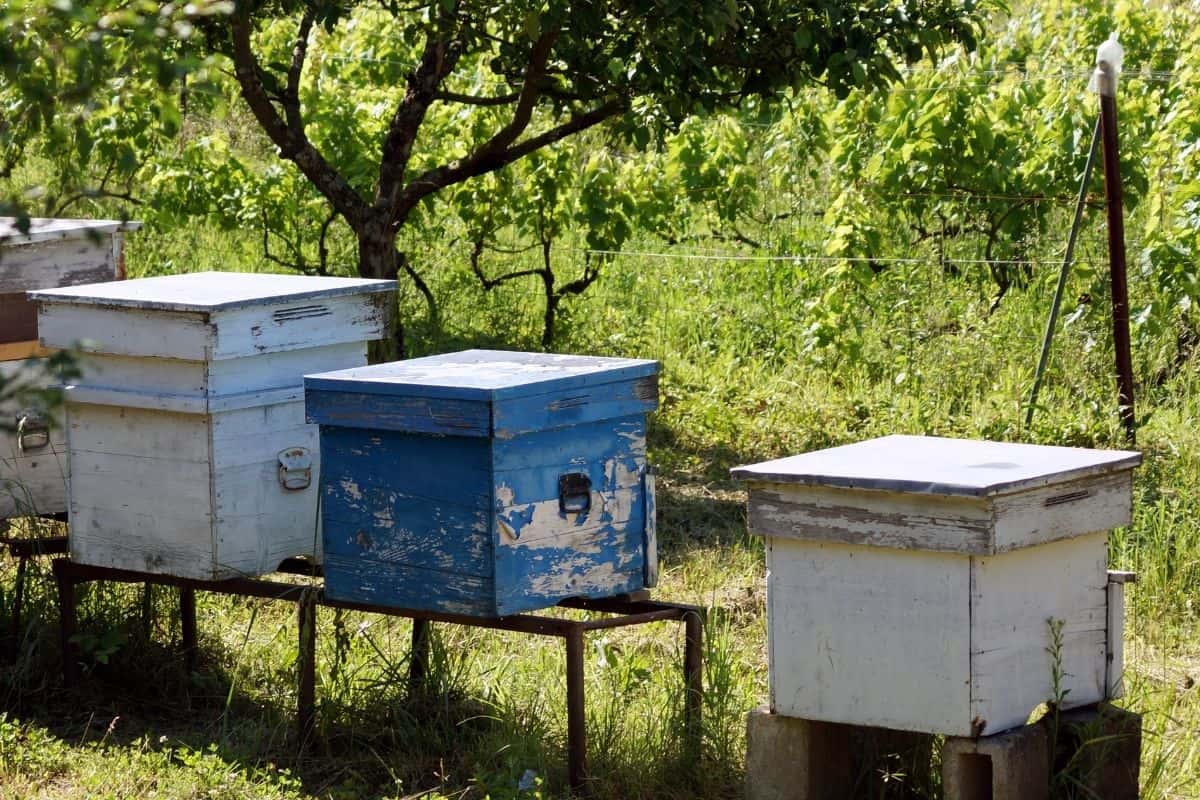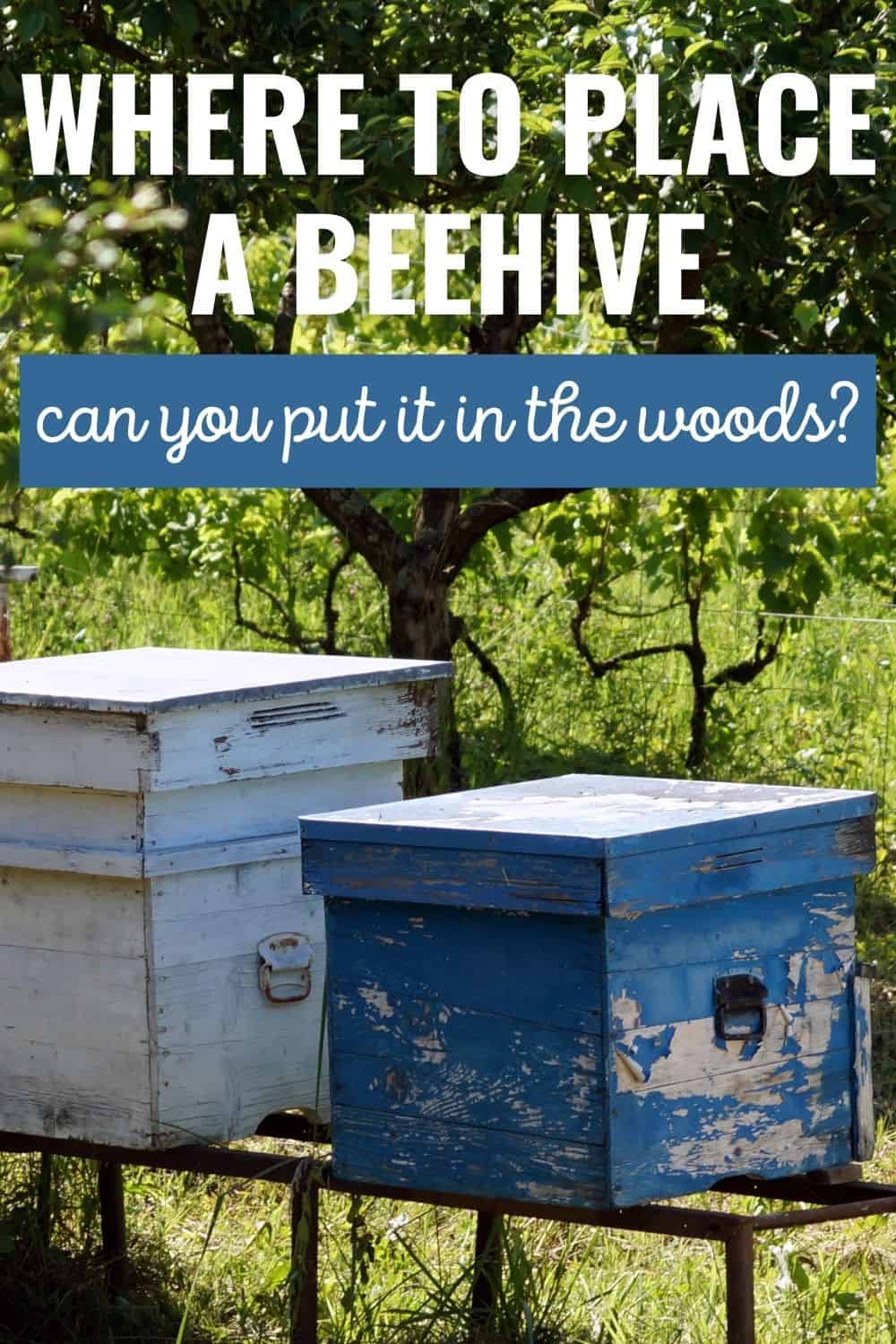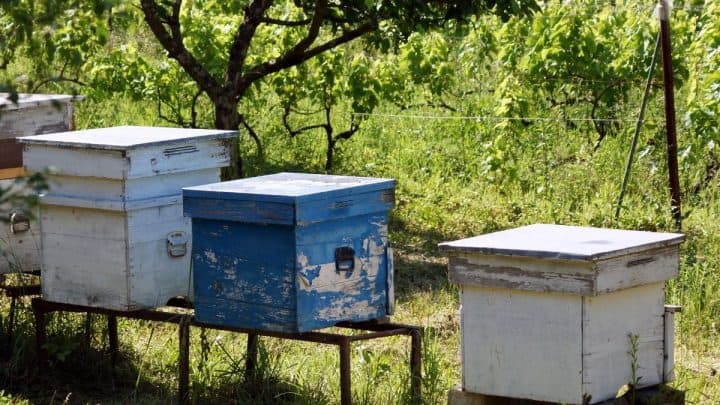Keeping bees requires some space which you may not always have on your property at your home. Wonder where to place a beehive? Beekeepers in need of space for their bees often turn to alternative spaces for their apiaries. One such alternative placing you may consider is putting your beehive in the woods. Is it possible to put a beehive in the woods, and are there any considerations when choosing this option?
You can place a beehive in the woods, but there are some aspects to this location that you should consider for your bees. There are risks of predators, pests, theft, and damage that you should consider. Another aspect is whether the location has enough resources for the bees.

Beekeeping is a rewarding activity for the beekeeper and the bees, but it requires adequate space for the bees to operate. Many hobby beekeepers start off keeping bees in their backyard, but at some point, as their colonies expand, they need to find alternative locations for their hives. Can you place beehives in the woods, and if you can, should you choose this option?
Are You Allowed To Put A Beehive In The Woods?
One of the first aspects to consider about putting a beehive in the woods is whether you are allowed to place your bees on this land or not.
If you have a forested area or a wilderness area in mind where you would like to place your bees, you need to find out who the land belongs to. Placing your beehive on a property without permission could get you in big trouble.
Can you put bees on federal land?
The government owns much of the wide-open spaces. Even though vast parts of this land may be vacant, the government controls the activities allowed on the land.
You can keep beehives on federal land, but you need permission by way of permits to do so. Permits may not be granted for all federal land, especially in sensitive conservation areas where the introduction of the honey bee could threaten the survival of other pollinators.
Permits may also not be granted if the area is used as public land, and the placing of beehives could cause a public nuisance for activities on the land.
Some states actively encourage the placement of beehives on land under their control, but only within the confines of the permitting system.
The permit system controls the number of hives placed on the land to prevent overcrowding and prevent the bee colonies from becoming a problem for native pollinators in the area. The hives located on federal land must comply with certain restrictions and be subject to inspection to prevent the introduction of pests and disease onto the property.
In many states, you must be a registered beekeeper before your application is considered, which may rule out some hobby beekeepers.
The permits for keeping bees on Federal land are usually administered by the local USDA office in your state. If the land is wilderness land, it is often administered by the Forestry branch of the USDA in your area.
Placing beehives on federal land without the necessary permits can result in the confiscation of the hive and hefty fines levied on the hive owner.
Can you keep bees in the woods on private land?
If the area in the woods is privately owned, it may be possible for you to put bees on the land. If you own the land, you can place bees wherever you like. If you do not own the land, you need to seek permission from the landowner.
Most landowners will be open to having bees placed on their land so long as the positioning of the bees will not interfere with any of the landowner’s activities. Some landowners may require compensation for the land use, such as a portion of the honey harvest.
Placing bees on private property without the landowner’s consent is trespassing and should not be done under any circumstances.
What Are The Risks Of Putting A Beehive In The Woods
Placing a beehive in the woods may sound like a good idea since the bees will have plenty of space. However, this open space may come with dangers for the bees and present some challenges for you as the beekeeper.
The risks involved will depend on the locale you are considering for your bees, and all risks may not apply to all areas. You will need to evaluate the risks involved for each area and contemplate whether the risks outweigh the benefits of placing your hive in the location.
Learn more about backyard beekeeping.
1. Not enough food for the beehive
Bees will travel far and wide to find resources for their colony and ensure the survival of the swarm, but the availability of forage will determine how hard the bees must work.
Honey bees will travel anywhere from 3 to 5-miles from the hive in search of suitable forage. The further the food and water is from the hive, the harder the bees will have to work for the colony to flourish. If the resources are insufficient, the bees may swarm off to search for a better forage location.
Limited forage will result in the bee colony struggling to increase and flourish. The bees will have to work harder, which means they will have a shorter lifespan. This, in turn, requires the queen to lay more eggs to produce more workers. This additional work requires additional resources.
If the resources are not available in the local area to support the colony, the colony will send out scouts to find a more suitable area. If the scouts find a location with better resources, the colony may abandon the hive for greener pastures.
You should evaluate the plants in the woods to ensure that the bees will have enough forage and fresh water available in the summertime and the winter to sustain the colony.
2. Lower honey production
If the area in the woods where you want to locate your bees is far from commercial crops or suburban gardens, the colony’s honey production may be reduced.
The woods or wilderness areas usually do not have the diversity or volume of forage for bees to produce large quantities of honey. Placing a beehive in the woods may reduce the honey production of the hive, reducing the value of placing a beehive in the woods.
If you are a hobby beekeeper, the reduction in honey production may not be of much concern to you. If you intend to make your beekeeping a commercial venture, the woods may not be an ideal location for your beehive.
Many beekeepers take their beehives to the woods at certain times of the year when plants in the wilderness of particular interest are in bloom. Once the blooming of these plants is over, the beekeepers move the beehives to more productive areas.
3. Pests for a beehive in the woods
Certain pests can invade the beehive, and in some cases, if the infestation becomes too great, the colony may abandon the hive and move to a more suitable location.
If you place your beehive in the woods and the area is too shaded, it could encourage the proliferation of small hive beetles in the hive. If the infestation of these beetles in the hive becomes too great, the bees will swarm off in search of a different location.
Small hive beetles are a pest that many beekeepers struggle with. These beetles thrive in shaded wooded areas. Placing a beehive in this location could present the beetles with an open invitation to invade the beehive.
Placing beehives in the sun helps prevent the small hive beetles from considering the hive as a suitable breeding ground. The beetle larvae eat through the comb, the honey, pollen and also eat the bees’ brood, making them very destructive to a beehive.
In most cases, the bees will fight off a mild infestation of these beetles, but if the infestation becomes overwhelming to the bees, the bees will abscond.
4. Predator and natural disaster dangers for hives placed in the woods
Having beehives in the woods means the bees are exposed to all the wildlife in the area. Some of these wildlife species can be problematic for your hive.
If predators such as bears and skunks live in the woods where you have located your bees, you need to take precautions to protect your beehive from these animals. Bears can destroy a hive completely to gain access to the honey and bee larvae, and skunks will eat the bees.
Bears can decimate an apiary site in a matter of minutes. They will break open the hives, destroying them in the process, and the bees will leave after their home is destroyed. The only way to keep bears out is by erecting an electric fence around the site when you install the bees.
If a bear has raided your site before, an electric fence will not deter him from his tasty treat. If the bears in the area have discovered your site as an easy meal, you will have to move all the hives to a new area or risk losing them all.
Skunks can be deterred by elevating hives off the ground to a height of at least 18-inches, but preferably 2-feet above ground level.
The costs involved in protecting the beehives against these natural marauders and the risk of losing entire beehives may make it impractical to keep your beehive in the woods.
Natural disasters are another concern for keeping a beehive in the woods. Beehives in natural locations are susceptible to all that nature throws at them. Forest fires sweeping through wooded areas destroy everything in their path, including your bees and beehives.
Other natural events such as falling branches, falling trees, heavy snow, landslides, and periodic flooding can all jeopardize the safety of your hive in the woods.
When your beehive is out in the woods, it is not easy to protect them from every circumstance, so you should be prepared to face some losses with your beekeeping when placing hives in these locations.
5. Danger of vandalism and theft
Bees in the woods on federal land or on land that is not your own may get unwanted attention from people with malicious intent.
If your bees are on a property not under your control, you have no say in the people who will enter the property and gain access to your bees. Beehives on land with public access are often vandalized maliciously or for the theft of the honey. In some cases, entire colonies were stolen.
There is no accounting for human behavior, which puts your hives at risk on a property where access is not controlled. Some beekeepers have had hives knocked over for no apparent reason by passersby, and some have had hives broken open by thieves who have stolen the honey.
Beekeepers with hives on wooded land have reported the theft of entire colonies of bees, hives, and beehive stands. There is always a risk that your bees and beehives will not be in the same condition that you left them the next time you visit the site.
Accessibility To The Beehive In The Woods
Placing a beehive in the woods implies that the hive is in a location that is remote from your home. This can have implications for the maintenance of the hive and the harvesting of the honey.
Hives that are some distance from your home will receive less attention and maintenance than a hive located in your backyard. It is more difficult to know what is happening with a hive in a remote location that you cannot monitor on a regular basis.
Trips to a remote apiary site will need to be planned and will cost you time and fuel to get to the apiary site and perform the required maintenance on the hives or harvest honey.
Hive maintenance and harvesting require equipment to be carried to the apiary site. For a hive located in the woods, you should ensure that you can have vehicle access within carrying distance of the site.
Remote sites increase the cost of beekeeping unless the location is only a short distance away from your home. It is generally only worthwhile to have remote locations if you are expanding your beekeeping operation to the point of making it a commercial undertaking.
The inconvenience of having a beehive in the woods may cause you to neglect the maintenance of the hive, which is not good for the bees or their production. You may also fail to notice problems in the hive quickly, such as small hive beetles or varroa mites, until the problem is beyond intervention.
In Conclusion, Can You Put A Beehive In The Woods?
Beekeeping is an activity that is similar to farming. You are reliant on nature and the environment for your enterprise to thrive.
Placing a beehive in the woods may seem like a great idea because it is a natural environment for the bees. Unfortunately, the dangers for your beehives may actually increase rather than decrease by placing your hive in the woods.
The dangers of pests, predators, natural disasters, environmental conditions, logistical challenges, and danger from uncontrolled access for people could pose more problems for a beekeeper than what it is worth.
Placing hives in the woods at certain times for certain nectar flows can be done, but leaving a beehive in the woods long-term is not a recommended practice unless you own the property.



